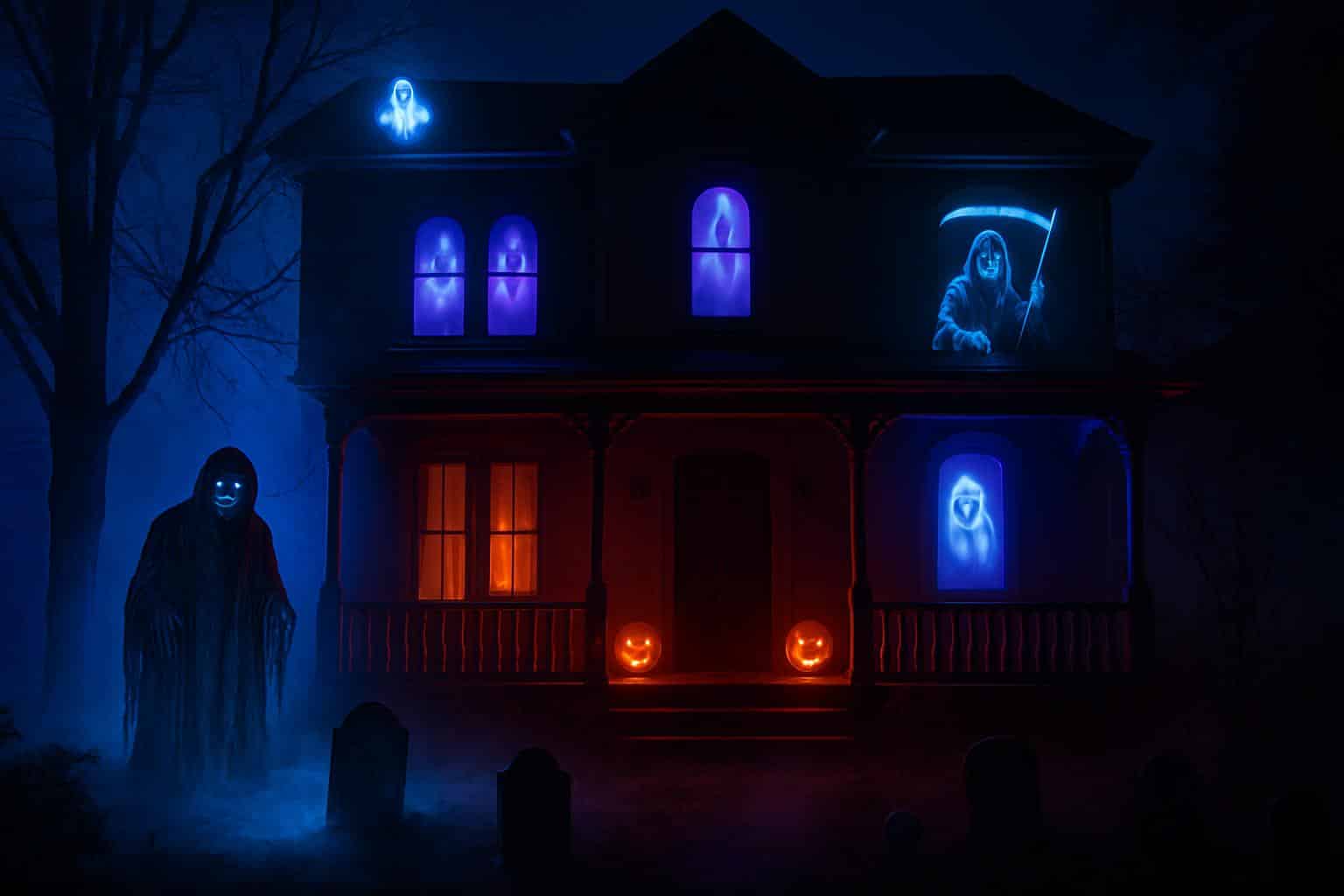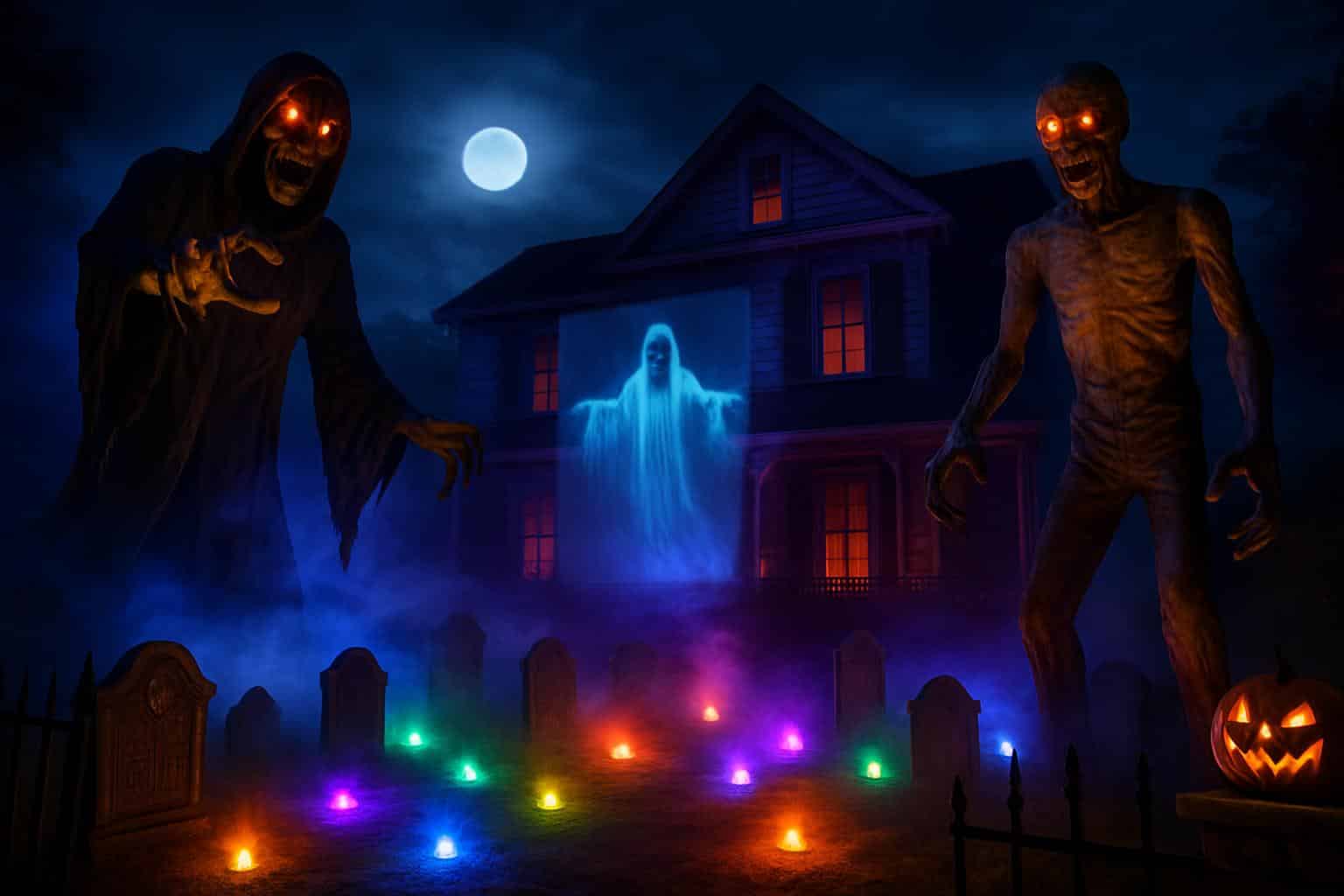Halloween is now a neighborhood-scale stage show, and the headliners aren’t plastic gravestones — they’re towering animatronics, cinematic projections and synchronized smart lights. After all, retailers keep adding to their lineups because the demand is there: Last year, by the National Retail Federation’s estimate, Americans spent a record $12.2 billion on Halloween activities (and some 74% of U.S. consumers planned to join in). The result is an arms race of spectacle — one that has moved far beyond porch pumpkins.
The trend this year is clear: bigger characters, sharper images, smarter control.
- Giant Animatronics Take the Outdoor Main Stage
- Projectors Add Serious Fright Factor With Cinematic Effects
- Smart Lighting Sets the Scene With Color and Control
- Sound, Sensors, and Control Bring Scenes to Life
- Power and Safety Essentials for Outdoor Halloween Shows
- Sustainability and Reuse Tips to Reduce Waste and Costs
- The Cost and the Starting Point for Every Decorator

Some of the high-tech Halloween decor on the market now brings theme-park vibes home — without the need for a prop shop.
Giant Animatronics Take the Outdoor Main Stage
The megastar of today is still the giant in the backyard. Home-improvement chains sparked the trend with jumbo skeletons and reapers, and the category continues to develop further from there — with better mechanics and more expressive faces. Scout for such production touches as servo-driven head movements, synced audio, and LCD-type “live eyes” that follow passersby — all perks long the purview of pro haunted attractions.
If you are selecting just one such statement piece, think silhouette above all else. A scarecrow in a beak-shaped mask reads from a block away. A bony giant against a backdrop of trees is timeless. Night visibility counts, so favor models that have integrated LEDs and a dark, matte finish hiding supports. Use a smart outdoor plug to schedule run times; you want your large animatronics drawing as few watts as possible, commonly 100–300 watts.
Projectors Add Serious Fright Factor With Cinematic Effects
Nothing transforms a house from cheerful to cinematic like a nice projection. Companies like AtmosFX have brought downloadable scenes of ghostly apparitions, haunted portraits, and slithering shadows flooding into windows or “floating” in a yard when cast on mesh. The trick is just stagecraft: some kind of transparent scrim in front of a good projector, with the backlight toned way down and source well off-axis so it disappears.
To get truly satisfactory brightness outside, you really want at least 2,000 lumens in a shaded area and even 3,000 or more if there is ambient street lighting.
Short-throw projectors aid in tight yards, while rear projection against window film helps block glare. Loop clips shorter than 60 seconds on a media player, then connect motion sensors to your sound so the screams or whispers play as visitors approach. It’s incredible how much more realistic a simple loop feels with directional sound.
Smart Lighting Sets the Scene With Color and Control
RGB curtain lights and addressable strips have supplanted tangled strings of orange. Grid-style “curtain” panels from smart-lighting makers render sharp shapes — bats, beating hearts, color wipes — while net lights stealthily shroud shrubs without any discernible cabling. Look for IP65 or better weather ratings, and build palettes in layers: eerie purples for fill, sickly greens for highlights, and a warm amber wash along paths to navigate by without tripping over yourself.

Advanced users can trigger effects you’d see in a theater: a flickering lantern cue, lighting synced to thunder rumbles, or pixel maps that animate across your building. Casual decorators can still get pro-lite with app scenes and music sync. Matter-compatible outdoor plugs and hubs minimize app bloat, and for once you’ll be able to coordinate animatronics, foggers, or lights in the same routine.
Sound, Sensors, and Control Bring Scenes to Life
Audio sells the scare. Weatherproof speakers hidden low behind landscaping create a point source that makes whispers feel near, and footsteps seem to circle the yard. And a slim subwoofer can make thunder cracks and monster growls feel nearly as real, at not-so-earth-shaking volume levels so you don’t end up the neighbor from hell.
Match passive infrared sensors or mmWave presence sensors to your props for effects that trigger as guests move. A basic flow is effective: lights dim, projector cues a ghostly figure, animatronic whips its head, then a strobe flickers to suggest lightning. Keep routines under 20 seconds to avoid congestion and reset fast for the next group.
Power and Safety Essentials for Outdoor Halloween Shows
Big displays draw attention — and current. Connect using outdoor-rated cords (14-gauge or thicker for long runs), keep connections off the ground with cord domes, and plug into a GFCI-protected receptacle. The Electrical Safety Foundation International recommends looking for UL or ETL markings on lights and controllers; cheap, unlisted gear is a false economy in wet fall weather.
Power draw: Electric fog machines and inflatables tend to have an amperage spike on startup. Spread loads across circuits; label everything and, finally, test your entire show for two nights before the big night. If winds are predicted, stake inflatables from more than one spot and use sandbags; a 12-footer tipped on its side is not only a hazard but also a buzzkill.
Sustainability and Reuse Tips to Reduce Waste and Costs
But for all the fanfare, the tech can work well. LEDs are a power-sipping alternative to old strings, and the current state of animatronics tends to be stationary unless activated. Solar pathway props — glowing “eyes” in the shrubbery, say — contribute ambiance without a jumble of wiring. Care is easy and takes very little time; then it’s over: gear is stored for good, out of the way when necessary, ready to go when needed.
The Cost and the Starting Point for Every Decorator
Budget ranges vary widely. A convincing projector setup with a midrange unit, window film, and audio can fall between a few hundred to a thousand dollars. Jumbo-size animatronics start in the low hundreds and go up from there, depending on size, movement complexity, and other features. Smart lighting can be an incremental upgrade — start with one curtain panel or net and add on year over year.
If you’re decorating an apartment, go vertical: window projections, curtain light grids, and small six-foot animatronics for balconies. Homeowners can stack all three pillars — animatronics, projection, and lighting — for a walk-through experience. Take a page from theme parks to design sightlines, not just props. When the tech backs up a tale, one larger-than-life figure can bring traffic to a stop.

